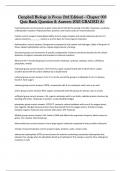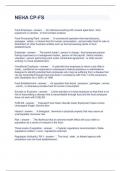Campbell Biology in Focus (3rd Edition) - Chapter 003
Quiz Bank Question & Answers 2023 GRADED A+
macromolecules correct answers a giant molecule formed by the joining of smaller molecules, usually by
a dehydration reaction. Polysaccharides, proteins, and nucleic acids are macromolecules
Carbon correct answers Unparalleled ability to form large complex and varied molecules due to its 4
valence electrons,________ melero se are the basis for most organic molecules
Hydrocarbons correct answers Compounds composed of only carbon and hydrogen, lipids of long tails of
these, always hydrophobic and can release large amount of energy
functional groups correct answers A specific configuration of atoms commonly attached to the carbon
skeletons of organic molecules and involved in chemical reactions
What are the 7 functional groups? correct answers hydroxyl, carbonyl, carboxyl, amino, sulfhydryl,
phosphate, methyl
hydroxyle group correct answers -OH, H forms a polar covalent bond with O which forms a polar
covalent bond with the carbon skeleton by a double bond
carbonyl group correct answers C=O, if it is at the end of the group it is aldehydes if not it is ketone,
found in most sugars
carboxyl group correct answers COOH, compounds with it are carboxylic acids, acts as an acid
amino group correct answers NH2, organic compounds with this group are amines, acts as a base
sulfhydryl group correct answers -SH, organic molecules with is are thiols, stabilize protein structure by
bonding with other -SH groups in protein, create disulfide bridges
phosphate group correct answers -OPO3^2- connects carbon backbone with one of its oxygen atoms,
two negative charges because protons have dissociated from the oxygen atoms, transfers energy
between organic molecules also interact with water, ATP molecule
Methyl group correct answers CH3, binds to DNA and affects the expression of genes, blocks access to
genes, non reactive chemical group
Macromolecules correct answers A very large organic molecule composed of many smaller molecules
4 kinda of macromolecules correct answers Lipids, proteins, carbs, nucleic acids
adenosine triphosphate (ATP) correct answers An adenine-containing nucleoside triphosphate that
releases free energy when its phosphate bonds are hydrolyzed. This energy is used to drive endergonic
reactions in cells
, polymer correct answers A long molecule consisting of many similar or identical monomers linked
together by covalent bonds. All do the macromolecules except for lipids
Monomer correct answers A simple compound whose molecules can join together to form polymers
enzymes correct answers A macromolecule serving as a catalyst, a chemical agent that increases the
rate of a reaction without being consumed y the reaction. Most enzymes are proteins
dehydration reaction correct answers A chemical reaction in which two molecules become covalently
bonded to each other with the removal of a water molecule
hydrolysis correct answers A chemical reaction that breaks bonds between two molecules by the
addition of water; functions in disassembly of polymers to monomers
carbohydrates correct answers A sugar (monosaccharide) or one of its dimer (dissacharides) or polymers
(polysaccharides)
Monomers of carbs correct answers Monosaccharides
monosaccharides correct answers The simplest carbohydrates, active alone or serving as a monomer for
disaccharides and polysaccharides. Also known as simple sugars, monosaccharides have molecular
formulas that are generally some multiple of CH2)
polysaccharides correct answers A polymer of many monosaccharides, formed by dehydration reactions
Disaccharides correct answers A double sugar, consisting of two monosaccharides joined by a glycosidic
linkage formed by a dehydration reaction
Functions of Carbohydrates correct answers Energy for cell, energy storage molecule, building material
Glycosidic linkage correct answers A covalent bond formed between two monosaccharides by a
dehydration reaction
Glycogen correct answers An extensively branched glucose storage polysaccharide found in the liver and
muscle of animals, the animal equivalent of starch
Cellulose correct answers A structural polysaccharide of plant cell walls, consisting of glucose monomers
joined by β glycosidic linkage
lipids correct answers Any of a group of large biological molecules, including fats, phospholipids, and
steroids, that mix poorly, if at all, with water
3 major types of lipids correct answers fats, phospholipids, steroids
chitin correct answers A structural polysaccharide consisting of amino sugar monomers, found in many
fungal cell walls and in the exoskeletons of all arthropods
organic compounds correct answers a chemical compound containing carbon





